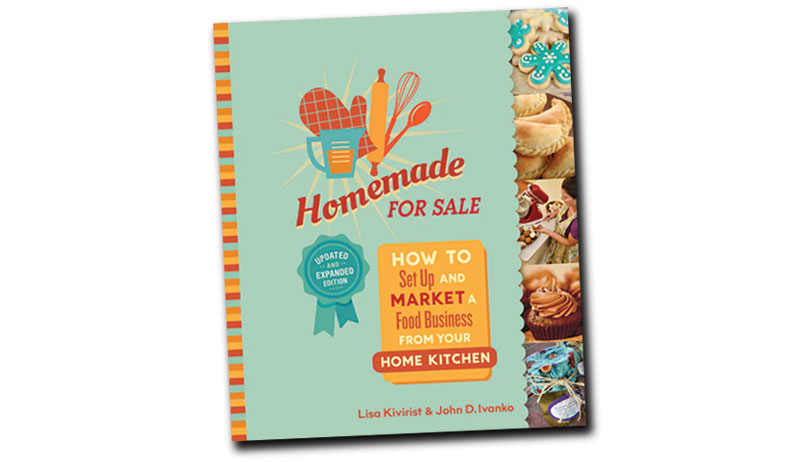
The following excerpt is from authors John Ivanko and Lisa Kivirist’s newest book, Homemade for Sale, Second Edition (New Society Publishers, December 2022: pre-order here now at a 20 percent discount) and is reprinted with permission from the publisher.

“There are all kinds of high-acid canned foods that we can choose to make and sell in our cottage home kitchens under your state’s cottage food law, everything from jams and jellies, fruit, butters, shrubs, pickles, sauerkraut, flavored vinegars, chutneys sauces, even juice,” says Renee Pottle, author of Profitable Preserves: How to Start an Artisan Jam and Jelly Business.
“So how do you know which product is the right one for you?” prompts Pottle. “Many of us have an idea with a recipe in mind, or maybe you grow an excess of apricots on your farm and you would like to make jam out of them. Perhaps you don’t grow anything, but you have a famous peach chutney recipe that all your friends and family tell you that you should make and sell.”
“First of all, whatever your canned product is, it should be something you love to make,” advises Pottle, who’s also a Master Food Preserver, getting started with canning as a child while hanging out in her Nana’s kitchen. “You will be making this product over and over. So, if you’re not crazy about the whole jelly-making process, don’t choose a jelly business.” This applies to any canned food product, not just jelly. The product has to be something you like to do.
“Do you have easy access to the ingredients needed to make your canned food product?” asks Pottle. “And are the ingredients affordable, if it turns out you buy them and not grow them yourself? Finally, when you add up the ingredient and packaging costs, plus factor in your labor, can you sell your products at a profit where you live?”
Sourcing locally or regionally tends to be the best way to keep the costs down and secure the high-quality ingredients, harvested at their peak of ripeness and, therefore, flavor. Beyond affordable and accessible ingredients, she’s quick to point out other potential bottlenecks, like the availability of canning jars, lids, or spices. Supply chain woes can crop up in unanticipated ways, so it’s wise to have a backup plan so production delays can be avoided.
Read more: These 5 methods of food preservation bypass canning altogether.
“Don’t swim upstream,” cautions Pottle. “Avoid choosing a product that you have to convince your customers to buy or that you have to overly explain. Most people understand jams and jellies and pickles and salsa. You might have to explain a regional fruit like marionberries, but people understand jam. However, they might walk right by your beautiful jars of mustard because they don’t understand it as a pickled product.”
“The biggest trade-off when working from our home kitchen is probably giving up a certain level of creativity,” admits Pottle. “Low-acid foods, like pepper jellies, usually aren’t allowed. Anything that includes alcohol, like wine jelly or ale jelly, probably isn’t allowed either under a cottage food law. For example, your state might let you make peach jam, but they won’t let you make persimmon jam. You might be able to make pickles from cucumbers, but not from carrots. The rules seem arbitrary, and to a certain degree they are.”
“Some states will let you make jam at home,” continues Pottle. “Some will let you make pickles at home. Some will let you make sauerkraut at home. Some will let you make two of those, but not the other. Some will let you make all three. So, before you get too excited about what you’re going to produce, make sure that you’ve checked to make sure it’s legal in your state. Either work with the cottage food law you have, or you’ll need to become an advocate and get the law changed in your state.”
“Because our products are in cans, the jars themselves sell your delicious home products at farm stands or pop-up food-related events,” says Pottle, noting that the colorful canned item has plenty of eye appeal and doesn’t need to be covered over by lots of labeling. “Be creative with labels, but there’s no need to get carried away with it. Stick with easy labels. Same for standard jars rather than the more expensive imported ones unless you’re sure you can get a lot more money for each jar sold. Otherwise, you’ll be losing any profit you might have made.”
“Starting a home-based business is always an exciting venture,” shares Pottle. “I’ve started several over the past three or four decades and in various locations and various types. We’re bubbling with optimism, but to keep that optimism, it’s best to avoid costly mistakes. Don’t get emotionally involved with either your product or your packaging. If something is too expensive, you have to be willing to give it up and move on to the next thing.”
“Remember, you are making delicious canned food products you love,” concludes Pottle. “You are sharing it with other people and they are paying you for it.” That’s the perfect recipe for business success.




